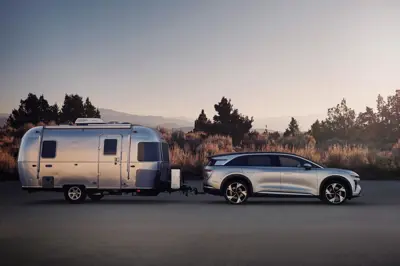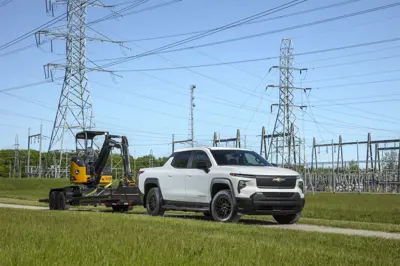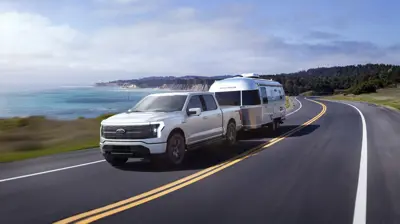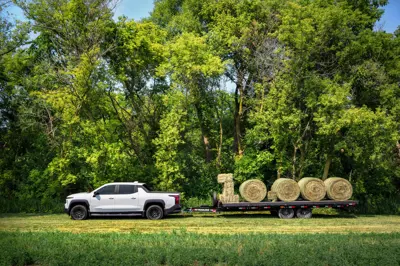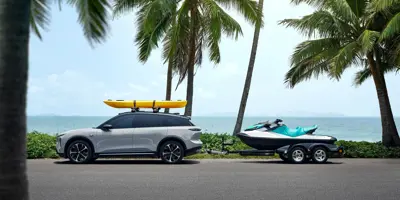- Cargo & Towing Capabilities
- Interior Cargo
- Frunk Cargo
- Roof Cargo
- Hitch Cargo
- Pickup Bed Cargo
- Towing
Towing
Electric vehicles are becoming more popular and practical for various purposes, including towing. However, many people may have questions or concerns about EVs' performance and range when towing a trailer.
This article addresses some of these issues and provides examples of EVs suitable for towing.
Advantages of EVs for Towing
EVs offer several advantages for towing:
- Instant Torque and Power Delivery: EVs can accelerate quickly and smoothly at any speed, making it easier to tow heavy loads without straining the engine or transmission.
- Regenerative Braking: EVs can recover some of the energy lost during braking and use it to recharge the battery, extending range and reducing brake wear.
- Enhanced Stability and Safety: Features like trailer sway control, adaptive cruise control, and blind spot monitoring improve towing safety.
For example, the Tesla Model X has an intelligent trailer feature that automatically adjusts suspension, braking, and steering to optimize performance and handling. The Rivian R1S has a four-wheel independent air suspension that adapts to different road conditions and trailer loads.
Challenges of EVs for Towing
Towing with an EV presents some challenges:
- Limited Range: EVs generally have a shorter range than conventional vehicles, and towing a trailer can reduce this range by 30% to 60%, depending on various factors like trailer weight, size, shape, and driving conditions.
- Trip Planning: EV owners need to plan trips carefully, ensuring sufficient battery charge and access to charging stations. Some EVs have navigation systems that calculate optimal routes and estimate energy consumption based on trailer characteristics and driving conditions.
For example, the Tesla Model X has a tow mode that adjusts range estimation and charging recommendations based on trailer weight and drag. The Ford F-150 Lightning has an intelligent range feature that factors in trailer load, weather, traffic, and driver behavior for more accurate range predictions.
Examples of EVs for Towing
Several EVs on the market or in development are suitable for towing. Here are some examples along with their towing capacities:
| Model | Max Trailer Weight |
|---|---|
| Rivian R1S | 3500 kg |
| Tesla Model X | 2250 kg |
| BMW iX | 2500 kg |
| Tesla Model Y | 1600 kg |
| Tesla Cybertruck | 4990 kg |
Vehicle Regulations
Different regions have varying regulations for the maximum trailer weight for different categories of cars. Here are some examples:
EU
The European Union defines several classes of cars based on the number of seats, wheels, and engine type:
- M1 Cars: Motor vehicles with at least four wheels and no more than eight seats in addition to the driver's seat. They can tow trailers with a maximum authorized weight of up to 3,500 kg.
- M2 Cars: Motor vehicles with more than eight seats and a maximum weight of 5,000 kg. They can tow trailers with a maximum authorized weight of up to 750 kg or more if the car and trailer combination is at most 12,000 kg.
- M3 Cars: Motor vehicles with more than eight seats and a maximum weight of more than 5,000 kg. They can tow trailers with a maximum authorized weight of up to 750 kg or more if the car and trailer combination is at most 18,000 kg.
- M4 Cars: Heavy-duty SUVs and pickup trucks with a maximum weight of more than 3,500 kg. They can tow trailers with a maximum authorized weight of up to 3,500 kg or more if the car and trailer combination is at most 12,000 kg.
- C1 Vehicles: Motor vehicles used for passenger carriage with a maximum mass exceeding 3.5 tonnes but not exceeding 7.5 tonnes. They can tow trailers with a maximum authorized weight of up to 750 kg or more if the vehicle and trailer combination is at most 12,000 kg.
- C2 Vehicles: Motor vehicles used for passenger carriage with a maximum mass exceeding 7.5 tonnes but not exceeding 18 tonnes. They can tow trailers with a maximum authorized weight of up to 750 kg or more if the vehicle and trailer combination is at most 18,000 kg.
- C3 Vehicles: Motor vehicles carrying passengers with a maximum mass exceeding 18 tonnes. They can tow trailers with a maximum authorized weight of up to 750 kg or more if the vehicle and trailer combination does not exceed 25,000 kg.
- N1 Vehicles: Motor vehicles carrying goods with a maximum mass not exceeding 3.5 tonnes. They can tow trailers with a maximum authorized weight of up to 750 kg or more if the vehicle and trailer combination is at most 12,000 kg.
- N2 Vehicles: Motor vehicles carrying goods with a maximum mass exceeding 3.5 tonnes but not exceeding 12 tonnes. They can tow trailers with a maximum authorized weight of up to 750 kg or more if the vehicle and trailer combination does not exceed 18,000 kg.
- N3 Vehicles: Motor vehicles carrying goods with a maximum mass exceeding 12 tonnes. They can tow trailers with a maximum authorized weight of up to 750 kg or more if the vehicle and trailer combination is at most 25,000 kg.
USA
The USA has similar vehicle categories to those of the European Union, but there are some differences in definitions and classifications. The USA uses four main agencies to define vehicle and engine types for emissions, fuel economy, safety, and statistics: the U.S. Environmental Protection Agency (EPA), the National Highway Traffic Safety Administration (NHTSA), the Federal Highway Administration (FHWA), and the U.S. Census Bureau.
The EPA and the NHTSA use the same vehicle categories for passenger vehicles and light-duty trucks based on the vehicles' interior volume and gross vehicle weight rating (GVWR). Passenger vehicles are divided into five classes: minicompact, subcompact, compact, mid-size, and large. Light-duty trucks are divided into four classes: Light light-duty trucks (LDT1), Light light-duty trucks (LDT2), Heavy light-duty trucks (LDT3), and Heavy light-duty trucks (LDT4).
The EPA and the NHTSA also use the same vehicle categories for heavy-duty vehicles based on the GVWR of the vehicles. Heavy-duty vehicles are divided into eight classes: 2b, 3, 4, 5, 6, 7, 8a, and 8b.
The FHWA and the U.S. Census Bureau use different vehicle categories for trucks based on the number of axles and the number of tires of the vehicles. Trucks are divided into 13 classes: single-unit 2-axle 4-tire, single-unit 2-axle 6-tire, single-unit 3-axle, single-unit 4 or more axles, combination 4 or fewer tires, combination 5-axle single-trailer, combination 6 or more axles single-trailer, combination 5 or fewer axles multi-trailer, combination 6-axle multi-trailer, combination 7 or more axles multi-trailer, truck tractor, chassis cab, and unknown truck type.
For a full overview of the different categories worldwide, visit TransportPolicy.net.
Search for EVs with Trailer Capability
See the complete list in the EVKX EV Database here.

